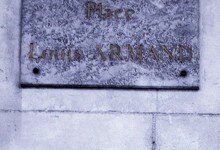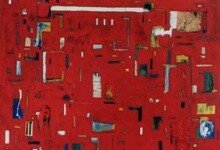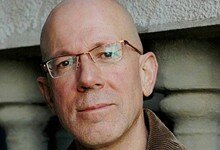The poetics of unplacement

Neither here nor there? On the anti-landscapism of displaced poets and the disappearance of setting in the poetry of Louis Armand
Home, we are often told, is where the heart is. More specifically, as another idiom would have it, there is no place like home. Can it be said, therefore, that human emotions are commonly perceived to be primarily and most closely associated with unique physical locations?
Simplistic and reductive as this question may appear, it addresses one of the key tenets of modern and contemporary poetry. A belief in an ineradicable, and highly sentimental, bond between a person’s subjectivity and singular, geographically specific loci is one of the key features of modern, post-modern and contemporary poetry. While it is commonly assumed that the height of poetic preoccupation with physical environment was reached in the 19th-century Romanticism (e.g., via the poets’ commitment to eulogising the Sublime Nature in the face of the rapacity of industrialisation), actual settings and landscapes have remained pivotal to the developments of poetry ever since. In the case of the Modernist American poet Wallace Stevens, for example, “landscape, and along with it the thorny relationship between a perceiving human consciousness and a surrounding nonhuman world, is at the very centre of [his] work,” and Stevens “is not alone, moreover, among modern American poetic voices in his concern with issues of landscape and place.”(i)
Fundamental concerns with place are not limited to modern American poets. The work of the contemporary Irish poet Moya Cannon, for example, whilst contesting an “[i]dealized simplification of landscape” is, nevertheless, entirely dependent on the poet’s “knowing the depth and color of [the land’s] specificities, engaging and perhaps traversing the heights of the [Irish] boglands.”(ii) Similarly incisive linguistic engagements with actual topographic entities as well as manmade environments are to be found in almost all contemporary poetic milieus. The work of the emerging Aboriginal Australian poet, Samuel Wagan Watson, for example, “invokes a space of local knowledge, of the land known in the blood, in the voices which refuse to be mere memory, merely of the past.”(iii) Wagan Watson’s post-colonial invocation of the visceral connections between a native people and their traditional land revokes the perception that a focus on place is an essentially European literary trope. As Jini Kim Watson has observed, for example, landscape is a crucial element in the work of widely different contemporary Singaporean poets: Edwin Thumboo refers to the natural as well as the industrialised scenery of Singapore in his poetry “to invoke the nation’s past,”(iv) while the late Arthur Yap’s poetry performs an “anthropomorphization of landscape”.(v)
However, although such a poetics of place is prominent in the work of so many modern and contemporary poetic voices, it is also clearly and crucially absent from the work of a small, albeit critical, number of fundamentally different, radical and influential poets. Place and landscape are not only denied significance in the work of Arthur Rimbaud, Aimé Césaire and a number of groundbreaking authors, but the linguistic references to setting and environment are significantly challenged and even negated in the work of these poets. We may discern what I shall term a poetics of unplacement in Rimbaud’s 1871 poem ‘Ce qu’on dit au poëte à propos de fleurs’ and Césaire’s celebrated 1939 long poem Cahier d’un retour au pays natal, and by briefly considering the systematic and clearly deliberate subtractions of place form the semantic fields within these poems, I shall propose that poets who do not possess an emotional/sentimental attachment to the environments in which they live, whom I shall refer to as displaced poets, practice a poetics radically different to what is apparent in the work of the majority of modern and contemporary poets.
Rimbaud’s ‘Ce qu’on dit au poëte à propos de fleurs’ was written during one of the teenaged poet’s nomadic movements between his native rural city of Charleville (now part of the commune of Charleville-Mézières in northeastern France) and Paris in 1871, possibly after the third time he ran away from home.(vi) As a striking aspect of its rebellious contempt for Paris’s politically conservative so-called Parnassian aesthete poets, Rimabud’s poem, addressed to a hypothetical conservative poet, ridicules and critiques the abundance of motifs and representations of the exotic, natural world in the Parnassians’ work. In the sixth stanza of the poem’s fourth section, for example, he equates the aesthetes’ nature poetry with a laughable fantasy of primitive hunting, while immediately associating this fantasy with the reality of France’s predatory imperialist yearning for exotic colonies:
Trouve, ô Chasseur, nous le voulons,
Quelques garances parfumées
Que la Nature en pantalons
Fasse éclore! – pour nos Armées! (vii)
The flora named in the second line of the quoted stanza (“garances parfumées”, or aromatic madder, a type of herb) is radically different to, for example, Wordsworth’s daffodils. Rimbaud’s flowers are nothing but disposable, ontologically empty signifiers exploited by the landscape poets’ self-aggrandising self-identification (as White hunters, botanists and explorers) which, in turn, intoxicates and sexually arouses the soldiers of French armies conquering African and Asian territories. As Kristin Ross has observed, Rimbaud’s discourse in this poem, in line with the arguments put forward by theorists of the Paris Commune, finds the conservative poets “guilty of a kind of ‘landscapism’” and is therefore “quick to link Parnassian exoticism to an elitist artistic posture and its attendant racism.”(viii)
Césaire’s Cahier d’un retour au pays natal displays a similar dismissal of poetic landscapism. Although it is commonly assumed that this seminal Modernist text is, at its title perhaps suggests, about a particular place – in which the poet has, according to one commentator, “put [his native land] Martinique at the centre of the picture, to magnify it in order to take a closer look at its beauties and uglinesses”(ix) – it is significant to point out that, as the same commentator has also acknowledged, the poem was written in France, prior to the poet’s return to his Caribbean birthplace, at a time when in the poet’s mind “the reality of the island was taking the form of an impossible escape from and a necessary return to the native land”.(x) This transformation of the geographical signifier from a geological referent to a mental, metaphysical notion exhibits a poetics that conveys a negation of a descriptive, picturesque (or unsightly) depiction of the poet’s surrounds. In the poem’s sixth stanza/paragraph, for example, it is not only the town, the subject of the passage, which is “flat” and “alienated from its flora and fauna”; the language of the prose-poetic passage itself, in its absolute refusal to linguistically portray the physical scenery by either accentuating its visual qualities or even naming its specific, characteristic plants and wildlife, is detached and dreary:
At the brink of dawn, this flat town – staked out, tripped of its common-sense, inert, panting under the geometric burden of its forever renascent cross, unresigned to its fate, dumb, thwarted in every way, incapable of growing along the sap of this soil burdened, clipped, diminished, alienated from its flora and fauna.(xi)
Although this passage could be read as a representation of an abject, colonised space, it significantly enacts the poet’s own conceptual “incapability” and “alienation” (“rupture” in the original French) from a poetic in which natural motifs such as “the sap of this soil” and “flora and fauna” can be represented as the synecdoches of a geographical location. Césaire’s rejection of describing the land as anything other than a void misrepresented by an imposed European Master Signifier (the “forever renascent cross”) is not only a potent critique of colonialism; it is also a renunciation of landscapism, and a manifestation of a poetics in which the literary tendency to portray place has been negated.
The similarities between Rimbaud’s and Césaire’s negative approaches to physical environment may be a result of the former’s direct influence on the latter (as seen in Césaire’s détournement of one of Rimbaud’s neologisms(xii) but perhaps a more compelling explanation can be found in the biographical fact of the two poets’ being displaced – that is, removed from their permanent homes – at the time of the composition of their work. Considering the radically innovative and avant-garde dimension of these poets’ works, Rimbaud’s acrid satire of nature poetry and Césaire’s inability/unwillingness to describe the natural environment of his native land seem consonant with what Raymond Williams has termed “radical estrangement”, a phenomenon observed in the work of the Modernist movements in the early 20th century in which “the experience of rapidly mobile émigrés in the migrant quarters of their cities”(xiii) provided the impetus for the iconoclastic stances and praxis of artists who revolutionized the arts. According to Williams, “the restlessly mobile émigré or exile” artists such as Picasso, Pound, Eliot, Joyce, Brecht and Beckett, as a result of experiencing a foreigner’s sense of linguistic and cultural alienation and the other effects of social dislocation, produced “an intense, singular narrative of unsettlement [and] homelessness”(xiv) which would in turn foment the momentum for the unsettling, disruptive and insubordinate raison d’être of Modernism.
This articel aims to investigate the consequences of such a radical estrangement, and its accompanying poetics, in two poems by the contemporary avant-gardist Australian poet, visual artist and intellectual Louis Armand who has been living and writing in Prague for the last 16 years. Without dwelling on the fact that Armand can be seen as a displaced, émigré poet due to his biographical details, I would like to discuss the startling treatment of land and geology in his poetry in order to propose that cultural milieus such as the amorphous and fungible communities of migrant, diaspora, peripatetic and expat artists that have existed in the Czech capital since the end of the Cold War – which have perhaps drawn on previous formations of various groups of minority, displaced and/or exiled artists and intellectuals in the city during the course of the 20th century – are fertile grounds for the kind of disruptive, highly unconventional artistic experimentalism and innovation that characterised Modernism. And one key aspect of the work of such avant-garde, displaced poets’ project is, as can be seen in the chosen poems from Armand’s 2001 collection Land Partition, the vigorous negation of the poetics of place and landscapism.
Louis Armand’s Partitioned Land
In his 1999 essay ‘Ground Zero Warholing’, in which he discusses the experimental work of his fellow expatriate Australian poet John Kinsella, Armand proposes that central to Kinsella’s poem ‘Syzygy’
is the question of how land is represented (in the visual arts, in politics, in economics, in poetry: i.e. ‘the pastoral tradition’), and how in Australia this process has been, since colonization, one of conflict between a mechanical ‘translation’ of land into ‘land-scape’ and a resistance to translation (an element of the inassimilable which enacts a deconstruction of the Western aesthetic, and so on).(xv)
Such a methodical critique of the linguistic and political representations of land is central to a genre of contemporary poetry known as ecopoetry in which the “relationship with nature is not governed by the human author’s (Romantic) volition to transform and own [non-human] reality in some form of linguistic representation.”(xvi) Perhaps due to such an environmentalist ethos as well as the aforementioned themes of displacement and estrangement, Armand’s own collection of poems Land Partition – to use the terms of his analysis of Kinsella’s work – enacts a simulation of the conflict between a conceptual “translation” of the land into “land-scape” and an aesthetic, ontological “resistance” to this articulation.
The poem ‘Field Composition’ can be seen to simultaneously embody and unsettle precisely such a discursive transformation of the geological signified into the linguistic field of commerce, geology and agribusiness:
FIELD COMPOSITION
dividing the field into its con-
stituent parts—the embankments of irrigation ditches
squaring-off the horizontal
curvature, mapping “libidinal flows” as index
of returns, market
growth or sustainability—a row of newly erected silos gleam
in the mid-winter sunlight, like
giant missives from some alien intelligence—strange helio-
tropes, urging upwards in effigie
of outside investor trends—the quarterly prospectus
hyping eco-consciousness as
eradication of liability, sighting long term gain in selective
reification, viz. rerum natura
as proto-readymade & categorical, as imperative straining to
make the point of eco-
nomic impact
well beyond the maximum yield(xvii)
In spite of the putative difficulties of Armand’s poetry – described by one critic as an “intensely complex”(xviii) writing which “requires a diligent reader”(xix) – it is immediately obvious that this piece can be seen as an ecopoem in which the commercial and discursive exploitation of the land are vividly illustrated through, for example, the enjambment separating the poem’s third last line from its second last line which draws the reader’s attention to the usurpation of “eco” by “eco-nomic.” It is important, however, to stress that points such as this have not been communicated via homiletic, valorising depictions of nature, but initiated via the cancellation and dissolution of the very language of (inevitably anthropocentric) nature writing. Armand’s poem does not resist the mistreatment of the natural world by celebrating a supposedly alternative and less pernicious relationship between humans and the environment, but it instead negates the poetic desire to linguistically represent and therefore possess landscapes and natural phenomena.
To further explore the operation of this counter-poetics in ‘Field Composition’, I would like to draw on a theoretical framework based on the philosopher Alain Badiou’s reading of a poem by Stéphane Mallarmé. Premised on the philosopher’s radical concept of the event (as explicated in his 1988 magnum opus L’être et l’événtment), Badiou’s discussion of Mallarmé’s sonnet ‘Ses purs ongles très haut’ proposes that the poem’s suggested, natural subject matter (the sunset) is not only about a vanishing (of the sun) but that the natural event of the sun’s vanishing (as an identifiable thing called sunset) has itself entirely vanished within the poem; that is, “so withdrawn as to be simply unnamable”.(xx) According to Badiou, Mallarmé has enacted this absolute disappearance of the scenic, natural referent through a set of “subtractive operations” within the poem, comprising:
- vanishing, whose value lies in marking;
- cancellation, which avers the undecidable and sustains the truth;
- foreclosure, which points to the unnamable, and fixes the uncrossable limit of a truth-process.(xxi)
By applying the above reading to Louis Armand’s ‘Field Composition’, we may analyse the ways in which the Prague-based Australian’s poem proposes that, if treated as an unnamable, place also possesses a uniqueness no discourse could possibly eliminate; and, crucially, this infinite and undecidable uniqueness could only be brought into being in the absence of a poetics of place, as a consequence of the negation of poetic landscapism.
The word “field” in the poem’s title and its first line does not at all name the natural entity, and immediately indicates the vanishing of the land, first via the jargon of agriculture and then via geometrical terminology: “dividing the field into its con- / stituent parts—the embankments of irrigation ditches / squaring-off the horizontal / curvature”. Under a palimpsest of increasingly obfuscating terms (from lexicons of land surveying, cartography, economics, etc.) the land is momentarily resurrected when the apparent entanglements of the poem’s language are interrupted by the rural imagery in the sixth line, as “a row of newly erected silos gleam / in the mid-winter sunlight.” This direct image, an obvious nod to landscape poetry, performs a function similar to that of the nymph in Mallarmé’s poem: it comes close to representing the natural, scenic reality (the sunset in Mallarmé’s case, the land in Armand’s) in a conventional poetic tradition (Symbolism in the former, pastoral poetry in the latter). Yet, as with Mallarmé’s poem, this vanishing is itself immediately cancelled, in this case via a simile which hints at something unfathomable, utterly mysterious and unnamable:
—a row of newly erected silos gleam
in the mid-winter sunlight, like
giant missives from some alien intelligence—strange helio-
tropes
The rural image’s cancellation by an indeed “strange” comparison to communication from outer space, and the breakdown of the flora’s name into two components that point to a physically that transcends the land (“helio,” the sun) as well as a rhetorical concept (“tropes”), are lucid and cogent instances of Armand’s poetics of unplacement in action. Instead of attempting to resuscitate the land from the scene of its vanishing by resorting to mawkish, Romantic images (of natural, pre-industrial, primitive beauty, serenity, etc.) Armand ruptures the very tropes of such imagism to disclose nature as that which, to paraphrase Badiou, possesses a singularity that no poetic, semantic or systemic human hegemony could ever obliterate. To foreclose any chance of a return to nature poetry as a reaction against the land’s physical and conceptual depredations, the rest of Armand’s poem equates the (pseudo-) environmentalism of corporations with a manmade, literary artifice (“viz. rerum natura”), an overwrought Kantian axiom, and, ultimately, a ruse for increasing profits “beyond the maximum yield.” By negating these terms’ intention to signify the land, Armand presents the “radical lack” of a positivist concept of place in his poetics. His poem embodies a fundamental and committed absence of a perception of the environment.
As another example of this crucial and programmatic disappearance of setting in Armand’s poetry, we may briefly consider “Biodegradable,” also from the 2001 collection Land Partition (a more recent version of this poem, as published in The Penguin Anthology of Australian Poetry in 2009, has a somewhat different typography(xxvii):
BIODEGRADABLE
arriving elsewhere, there are fundamental questions
of locality, modularized space—the dividing line of
separate hypotheses & the river charting a passage
of illicit traffic, carnal (the bare “that it is” in the
“nothing of the world”)—a bridge flares into view
& recedes again into urban renewal, like time
suddenly focused on some inevitable, statistical average
or cognitive sculpture arching out of bipolarity
disorder in the barely initiated idea, a mere ornament
of style—above the skyline the remote etymologies wink
conspiratorially, faux blond in a fugitive midnight hustle:
then just as soon it’s over again, the agitation passing to
usedness, wastage—a damaged landform stag-
gering upright & dissolving in brief nocturnal laughter(xviii)
To discuss this poem under the rubric of Badiou’s ternary “subtractive operations”, we may first discern that the being of the place at which the poem’s speaker has arrived (here) vanishes under the “fundamental questions / of locality, modularized space”. Traces of the poem’s setting appear – “the river charting a passage;” “a bridge flares into view” – but these marks are immediately cancelled by psychogeographical motifs such as the “cognitive sculpture arching out of bipolarity / disorder.” To present the speaker’s whereabouts as a fundamentally and radically subtracted concept, however, the poem cannot end with statements of disorientation and disorder. It requires, as Badiou would have it, a “foreclosure” which indicates the poem’s setting as absolutely unnamable and infinite; and such a final annihilation of any possibility of place being named by the poet is precisely what is illustrated by the observation that “above the skyline remote etymologies wink / conspiratorially” and “a damaged landform stag- / gering upright & dissolving in brief nocturnal laughter.” The final dissolution of the concrete, topographical item in the poem’s last line is not due to its being “damaged” or “wasted”, but an effect of the poem’s trenchant and comprehensive anti-landscapism.
Conclusion
In the conclusion to his 1997 essay on the seminal avant-garde Australian poet Michael Dransfield, Armand writes what may be viewed as a statement towards a poetic manifesto of his own:
the poet must stake everything against the world in order to be for the world – that poetry must assume the form, as Blake says, of an excess that constantly opens language to the experience of the possible, and whose ethics is not vested in the poet’s judgment but in the conditions of poetry. It may be that poetry makes nothing happen, if only for the reason that poetry is what happens – it is the language by which the world speaks to what it may become, to its possibility, to its invention.(xxix)
In the context of what this chapter has tried to examine, it can be said that Armand’s proclivity to “stake everything against the world in order to be for the world” is effectively illustrated by the treatment of place in the above-discussed poems; that is, by refusing to verbally depict and represent place and the environment in his work, he has written poems that are entirely for a conceptualisation of the environment as an unnamable, inestimable and therefore entirely singular being. As such, by refusing to speak about place, Armand’s poetry functions as the language by which place can come into being qua being, as an utterly non-human, unspeakable entity, not sequestered by the poet’s semantic, symbolic and metaphoric demands and compulsions, but open “to what it may become, to its possibility, to its invention”.
As we have seen, such a poetics can be seen in the work of earlier radical, displaced poets such as Rimbaud and Césaire; but is Armand alone among contemporary poets (in an age dominated by geo-spacial issues to do with ecology, extreme natural phenomena, border conflicts and border security, expanding metropolises and their accompanying slums, etc.) in his obstinate rejection of a poetics of place and landscapism? Is he not an oddity in, for example, his native Australian literary milieu, a scene that has been identified as one almost solely preoccupied with rural and/or urban sceneries?(xxx) As such, Armand’s poetics is more of a rarity than an absolute exception. In an Australian context, for example, his negating attitude towards landscape is shared by a small number of experimentalist poets such as the Polish-Australian Ania Walwicz who – perhaps due to the fact of herself being a displaced, migrant poet – displays a vivid exemplification of what I have been referring to as a poetics of unplacement. In her prose-poem ‘Australia’, for example, she not only finds her new country’s social as well as natural landscapes aesthetically unappealing, but she empathically refuses to look for, observe and describe any beauty in the land and its people:
You big ugly. You too empty. You desert with your nothing nothing nothing. You scorched suntanned. Old too quickly. Acres of suburbs watching the telly. You bore me. Freckle silly children. You nothing much. With your big sea. Beach beach beach. I’ve seen enough already(xxxi)
In a way, it can be said that Armand has also seen enough of lands, topographies and localities; but neither his – nor Walwicz’s – poetics should be mistaken for an expression of ennui or a kind of literary travel/home sickness. In view of the unwavering opposition to a poetics of place in his poems, it would be apt to say that this aspect of Armand’s work is an active and significant dimension of his entire poetic project. As to what extent, if any, this poetics of unplacement is shared by Armand’s fellow expat, Prague-based poets, this would be something that may be explored in the other chapters of this anthology or other anthologies like it. For now, it should suffice to conclude that, according to at least one nomadic, contemporary poet, even if home continues to be where the heart is, home is not rigidly defined, limited and constrained by the poetic and conceptual confines of a set place.
References
(i) William Hogan, ‘Review of Shifting Ground: Reinventing Landscape in Modern American Poetry’, Journal of Modern Literature 27.4, Summer 2004, p. 129
(xxiii) Stephané Mallarmé, Selected Poetry and Prose, ed. Mary Ann Caws, New Directions, New York, 1982, p. 48








